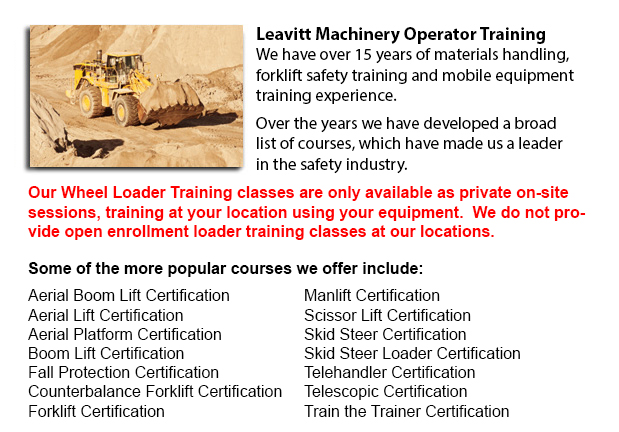
Kamloops Wheel Loader Operator Training - To be able to raise substantial loads, industrial cranes utilize pulleys and levers. In the past, Roman people utilized cranes in order to raise enormous monuments making the origin of these machines at least two thousand years ago. Numerous Medieval churches utilized cranes in their building as well as the Egyptian people might have used them when constructing the pyramids.
The modern kind of a crane could be either simple or complex, and cranes differ based on their use. Mobile cranes, for instance are somewhat simple. A telescopic boom or steel truss mounts its movable platform. A system of pulleys or levers raises the boom and there is often a hook suspended. These cranes are normally used for earthmoving or demolition by changing the hook out with another piece of equipment like for example a wrecking ball or a bucket. Telescopic cranes have a series of hydraulic tubes that fit together to form the boom. These units could even be mobile.
Conventional wheels, or certain wheels designed for a caterpillar track or railroad track allow these mobile booms to navigate unpaved and uneven surfaces.
Truck mounted and rough terrain cranes are mobile as well. Outriggers are located on the truck mounted unit to enhance stability, while rough terrain cranes consist of a base which tends to resemble the bottom of a 4-wheel drive. These cranes are equipped to operate on rough ground making them ideal in the construction industry for instance.
Gantry cranes are actually used to be able to move and unload huge containers off of trains and ships. They are most often seen working in ports and railroads. Their bases include very big crossbeams that run on rails in order to pick up containers from one location to another. A portainer is a unique type of gantry which moves supplies onto and off of ships specifically.
Floating cranes are mounted on barges or pontoons and are one more vital piece of equipment essential to the shipping business. For the reason that they are situated in water, they are designed for a variety of services including salvaging ships, port construction and building bridges. Floating cranes can handle very heavy cargo and containers and similar to portainers, they could even unload ships.
Loader cranes consist of hydraulic driven booms that are fitted onto trailers to load merchandise onto a trailer. The jointed sections of the boom can be folded down when the machine is not in being used. This type of crane can be also considered telescopic in view of the fact that one part of the boom may telescope for more versatility.
Stacker cranes are normally used in automated warehouses. They tend to follow an automated retrieval system and could function by remote. These cranes are outfitted together with a lift truck equipment and can be seen in large automated freezers, stacking or obtaining foodstuff. Utilizing this kind of system enables staff to remain out of that cold environment.
Tower cranes, normally the tallest type, typically do not have a movable base. They should be assembled piece by piece. Their base is like a long ladder along with the boom at a 90 degree angle to the base. These cranes specialize in the construction of tall buildings and are usually connected to the inside of the building itself through the construction period.
-
Kamloops Counterbalance Forklift Training
Kamloops Counterbalance Forklift Training - Counterbalance Forklift Training courses are always in high demand. The Counterbalance forklift is a forklift which is made with a weight which counters the balance, equally spreading the weight of the load... More -
Kamloops Manlift Certification
Kamloops Manlift Certification - The Manlifts and Elevated Platforms program offers training on the rules, regulations and proper application of safe operating measures and work practices included in daily activities for people who work making use of... More -
Kamloops Boom Lift Training
Kamloops Boom Lift Training - Elevated work platforms, likewise referred to as aerial platforms, allow workers to carry out tasks at heights that will otherwise be not reachable. There are various styles of lifts designed for different site applicati... More -
Operator Safety Certification | Re-Qualification Certification | In-House Instructor Certification in Kamloops
Forklifts are used in just about all industrial construction sites and in warehouse operations and in boat yards. The reach feature of a lift truck is a vital component used in several applications like for instance when a shelving system is being us... More -
Kamloops Manlift Safety Training
Kamloops Manlift Safety Training - It is essential for competent Manlift operators to be aware of the connected dangers that come with particular kinds of scissor lifts. They must be able to operate the scissor lift in a way that protects not only th... More -
Kamloops Crane Training Schools
Kamloops Crane Training Schools - We have designed several programs for Mobile Crane Operation at our Crane Training Schools. These programs are recommended for the experienced operator who requires certification or re-certification, and for inexperi... More -
Skid Steer Loader Certification in Kamloops
The engine powered skid-steer loader consists of a rigid and small frame, outfitted together with lift arms which could attach to a lot of industrial attachments and tools to perform several labor saving jobs. Typically, skid-steer loaders are four-w... More -
Kamloops Heavy Equipment License
Kamloops Heavy Equipment License - A heavy equipment license could be acquired by taking a certification and preparation course at a private training school or a vocational school. This license would qualify you to operate various types of heavy mach... More

Forklift Certification Kamloops
TOLL FREE: 1-888-254-6157
Kamloops, British Columbia
forkliftcertificationkamloops.com/
Email Us
About Us


